Multan
| Multan مُلتان | |
|---|---|
| City District | |
 | |
| Nickname(s): The City of Sufis, The City of Saints, The City of Tombs, Madinat-ul-Auliya | |
 Multan Location in Pakistan | |
| Coordinates: 30°11′52″N 71°28′11″E / 30.19778°N 71.46972°ECoordinates: 30°11′52″N 71°28′11″E / 30.19778°N 71.46972°E | |
| Country |
|
| Region | Punjab |
| District | Multan District |
| Autonomous towns | 6 |
| Union councils | 4 |
| Government[1][2] | |
| • Nazim |
|
| Area | |
| • Total | 331 km2 (128 sq mi) |
| Elevation | 122 m (400 ft) |
| Population (1998)[3] | |
| • Total | 1,202,595 |
| Time zone | PST (UTC+5) |
| Area code(s) | 061 |
| Website | www.multan.gov.pk |
Multan (Urdu: مُلتان) (![]() pronunciation ), also known as city of saints, is a city of Punjab, Pakistan. It is Pakistan's fifth largest city by population and has an area of 133 square kilometres (51 sq mi). The city is located on the banks of the Chenab River in the geographic center of the country.
pronunciation ), also known as city of saints, is a city of Punjab, Pakistan. It is Pakistan's fifth largest city by population and has an area of 133 square kilometres (51 sq mi). The city is located on the banks of the Chenab River in the geographic center of the country.
Multan is known as the City of Sufis or City of Saints and Madinat-ul-Auliya because of the large number of shrines and Sufi saints from the city. The city is blanketed with bazaars, mosques, shrines, and ornate tombs. It is the birthplace of Fariduddin Ganjshakar (popularly known as "Baba Farid"), recognized as the first major poet of the Punjabi language. Multan is located in a bend created by five rivers of central Pakistan. The Sutlej River separates it from Bahawalpur and the Chenab River from Muzaffar Garh.One of the oldest Cities in the world dating back 6000 years, The city has grown to become an influential political and economical center for the country, with a dry port and excellent transport links. Multan is famous for its crops: wheat, cotton and sugar cane, mangoes, citrus, guavas, and pomegranates.
Government
Administrators who are government servants have the powers of Nazims (Mayor). Multan district is spread over an area of 3,721 square kilometers, comprising four tehsils: Multan City, Multan Saddar, Shujabad and Jalalpur Pirwala. In 2005 Multan was reorganised as a City District composed of six autonomous towns:
- Bosan
- Shah Rukan e Alam
- Mumtazabad
- Sher Shah
- Shujabad
- Jalalpur Pirwala
- Multan Cantonment
- New Multan
Demographics
Multan city has the estimated population of 5,250,098 in 2014.
More than 97% of the people are Muslims. The majority of Muslims are Sunni Hanafi, Ahl e hadith and the minority are Shia Ithna 'ashariyah. The Hindu population is approximately 20,000 and the Christian community numbers 25,000.
Language
- Multani (A local dialect of Punjabi, spoken by 52% of district population)
- Majhi ( Standard Punjabi dialect spoken by 25% of district population specially in cities and border area with Khanewal district)
- Raangrri/Rohtaki (18% population speaks this dialect a mixture of Punjabi and Urdu specially spoken in cities)
- Riasti (1% population near Border area with Bahawalpur and Lodhraan districts)
Other languages include:
- Urdu is mother tongue of few people but being national language is spoken and understood by the sizable population.
- English is also understood and spoken by the educated elite. *[Mewati] is a language which is spoken in everywhere in multan
History


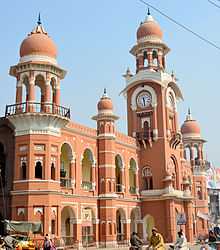

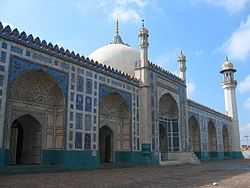
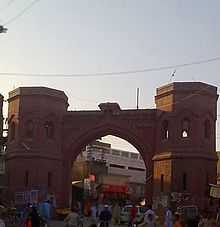
Multan is one of the oldest cities not only in the Asian subcontinent but also in the world dating back 6000 years when it was known as Maloha, a cultural and trade hub between Central Asia, South Asia and Persia.[4][5] According to Hindu legends, it was the capital of the Trigarta Kingdom at the time of the Mahabharata war, ruled by the Katoch Dynasty. Multan has had various names over the years. According to Hindu mythology, it was originally called Kashtpur (Kashyapapura) after a Hindu sage named Kashyapa, which is also the Gotra used by the Katoch dynasty.[6] Other names were Hanspur (Hamsapura), Bagpur (Vegapura), Sanb or Sanahpur (Sambapura).[7][8] It has been postulated that the current name is derived from the Sanskrit name Mulasthana named after a Sun Temple.[9][10] Multan has frequently been a site of conflict due to its location on a major invasion route between South Asia and Central Asia. It was conquered by Alexander the Great in 326 BC.
In the mid-5th century CE, the city was attacked by a group of Hephthalite nomads led by Toramana.
Multan was conquered along with Sindh by Muhammad bin Qasim, from the local ruler Chach of Alor circa 712 AD.Following bin Qasim's conquest, the city was securely under Muslim rule, although it was in effect an independent state and most of the subjects were non-Muslim.
In 965 CE, Multan was conquered by Halam b. Shayban, an Ismaili da'i. Soon after, Multan was attacked by Mahmud of Ghazni, destabilizing the Ismaili state. Mahmud of Ghazni invaded Multan in 1005 CE, conducting a series of campaigns during which the Ismailis of Multan were massacred.[11] In an effort to gain his allegiance, the Fatimid Ismaili Imam-caliph al-Hakim dispatched an envoy to Mahmud two years later. This attempt appeared to be unsuccessful and the Ghaznawids continued to attack other Ismaili strongholds in Sindh to suppress any resurgence of the community in the region. In 1032CE Mahmud's very own vizier, Hasanak was executed for having accepted a cloak from the Imam-caliph on suspicions that he had become an adherent of the Ismaili faith.[11] Mahmud's purges of the region led several scholars including Stern to believe that the Ghaznawid purges of the region drove out Ismailism from the area, however recently discovered letters dating to 1083 and 1088 demonstrate continued Ismaili activity in the region, as the Imam-caliph Mustansir dispatched new da'is to replace those who were killed in the attacks.[11]
Multan's location at the entrance to the sub-continent resulted in it being invaded by a long series of conquerors on their way to Delhi. Timur, Babur and many others passed through the city, leaving much destruction in their wake. This violence continued as when Muhammad of Ghor attacked the city and drove out the remaining Ismailis[12] whom he deemed to be heretics, in stark contrast to his predecessor, the Ghurid Sultan 'Ala' al-Din who welcomed numerous envoys from the Ismaili state of Alamut and according to the historian Juzjani, gave them "great reverence"[11] Following annexation to Mughal empire in 1557 CE, at the beginning of emperor Akbar's rule;[13] Multan enjoyed 200 years of peace, and became known as Dar al-Aman (Abode of Peace). Akbar was known as a wise ruler, setting reasonable taxes, creating effective government and being tolerant of religious differences.
Multan witnessed difficult times as Mughal rule declined in early 1700s, starting after death of emperor Aurangzeb in 1707. The last Naib Subahdars appointed by Farrukhsiyar at Multan were Khan Zaman Khan Ali Asghar ibn Kartalab Khan Bahadur Shahi Qazi Ghulam Mustafa and then Aqidat Khan ibn Ameer Khan.[14] In 1747, Ahmad Shah Durrani—who was born in Multan—rose to power. This counts as beginning of Durrani Empire. He captured Multan in 1752.[15]
In 1758, the Marathas under Raghunathrao captured Multan along with Lahore, Attock, Peshawar and Kashmir.[16][17]
The city was re-captured by Durrani in 1760. However, after death of Ahmad Shah Durrani in 1772, the influence of Durrani empire declined sharply in mere fifty years. Starting at late in 1700s, Multan was ruled locally by the Pashtun Sadozai and Khogyani aka Khakwani chieftains.
In 1817, Maharaja Ranjit Singh sent a body of troops to Multan under the command of Diwan Bhiwani Das to receive from Nawab Muzaffar Khan the tribute he owed to the Sikh Darbar. In 1818, Kharak Singh and Hindu Commander Diwan Misr Chand armies lay around Multan without making much initial headway. Maharaja Ranjit Singh sent a large cannon named Zamzama . Though in name Armies was commanded by Prince Kharak Singh however it was the military genius of Diwan Misr Chand which captured Multan Fort.
Muzzafar Khan urged the Majority Muslim population of Multan to fight a holy war against Sikhs and Hindus, however the tactics of Muzzafar Khan failed miserably as Sikh armies were able to suppress the religious revolt of Multan population. In the battle Diwan Misr Chand led Sikh armies to a decisive victory over Durrani General of Multan Nawab Muzaffar Khan. Muzzafar Khan and seven of his sons were killed before the Multan fort finally fell on 2 March 1818.[18][19] The death of Durrani General Nawab Muzzafar Khan brought the death of Muslim rule in Multan. After the defeat of Muslims in 1818, Multan came under Muslims only when British Empire divided India into two Portion and gave Muslim majority areas to Muslims in 1947.[20] Kharak Singh left Jodh Singh Ramgarhia with 600 men to guard the fort of Multan.[21] The Sikhs thereafter ruled Punjab until 1849, when it was lost in the Second Anglo-Sikh War.. Sardar Karan Narain's son was awarded the title 'Rai Bahadur' and knighted by the British Raj for switching to their side. After the Anglo-Sikh Wars, Multan was made part of the British Raj. The British built some rail routes to the city, but its industrial capacity was never developed. Muhammad Basher Ahmed Amretsri was revolted many time against British Government and died there.Choudy Ayzed Habib Arain and choudry Israr are the grandson of him. The predominantly Muslim population supported Muslim League and Pakistan Movement. After the independence of Pakistan in 1947, the minority Hindus and Sikhs migrated to India while the Muslim refugees from India settled in Multan. It initially lacked industry, hospitals and universities. Since then, there has been some industrial growth, and the city's population is continually growing. But the old city continues to be in a dilapidated state, and many monuments wear the effects of the warfare that has visited the city.
Geography and climate
| Multan | ||||||||||||||||||||||||||||||||||||||||||||||||||||||||||||
|---|---|---|---|---|---|---|---|---|---|---|---|---|---|---|---|---|---|---|---|---|---|---|---|---|---|---|---|---|---|---|---|---|---|---|---|---|---|---|---|---|---|---|---|---|---|---|---|---|---|---|---|---|---|---|---|---|---|---|---|---|
| Climate chart (explanation) | ||||||||||||||||||||||||||||||||||||||||||||||||||||||||||||
| ||||||||||||||||||||||||||||||||||||||||||||||||||||||||||||
| ||||||||||||||||||||||||||||||||||||||||||||||||||||||||||||

The city of Multan is located in Punjab. The nearest major cities are Dera Ghazi Khan and Bahawalpur. The area around the city is a flat, alluvial plain and is ideal for agriculture, with many citrus and mango farms. There are many canals that cut across the Multan District, providing water from nearby farms. This makes the land very fertile. However land close to the Chenab River is usually flooded in the monsoon season.
Multan features an arid climate (Köppen climate classification BWh) with very hot summers and mild winters. The city witnesses some of the most extreme weather in the country. The highest recorded temperature is approximately 54 °C (129 °F), and the lowest recorded temperature is approximately −1 °C (30 °F).[22][23] The average rainfall is roughly 186 millimetres (7.3 in). Dust storms are a common occurrence within the city.
| Climate data for Multan | |||||||||||||
|---|---|---|---|---|---|---|---|---|---|---|---|---|---|
| Month | Jan | Feb | Mar | Apr | May | Jun | Jul | Aug | Sep | Oct | Nov | Dec | Year |
| Record high °C (°F) | 28.3 (82.9) |
32.0 (89.6) |
39.0 (102.2) |
45.0 (113) |
48.9 (120) |
49.0 (120.2) |
47.2 (117) |
45.0 (113) |
42.5 (108.5) |
40.6 (105.1) |
36.0 (96.8) |
29.0 (84.2) |
49 (120.2) |
| Average high °C (°F) | 21.0 (69.8) |
23.2 (73.8) |
28.5 (83.3) |
35.5 (95.9) |
40.4 (104.7) |
42.3 (108.1) |
39.2 (102.6) |
38.0 (100.4) |
37.2 (99) |
34.6 (94.3) |
28.5 (83.3) |
22.7 (72.9) |
32.59 (90.68) |
| Daily mean °C (°F) | 12.7 (54.9) |
15.4 (59.7) |
21.0 (69.8) |
27.5 (81.5) |
32.4 (90.3) |
35.5 (95.9) |
33.9 (93) |
33.0 (91.4) |
31.0 (87.8) |
26.4 (79.5) |
19.7 (67.5) |
14.1 (57.4) |
25.22 (77.39) |
| Average low °C (°F) | 4.5 (40.1) |
7.6 (45.7) |
13.5 (56.3) |
19.5 (67.1) |
24.4 (75.9) |
28.6 (83.5) |
28.7 (83.7) |
28.0 (82.4) |
24.9 (76.8) |
18.2 (64.8) |
10.9 (51.6) |
5.5 (41.9) |
17.86 (64.15) |
| Record low °C (°F) | −3.9 (25) |
−2.0 (28.4) |
3.3 (37.9) |
9.4 (48.9) |
13.5 (56.3) |
20.0 (68) |
21.1 (70) |
21.1 (70) |
16.7 (62.1) |
8.9 (48) |
0.6 (33.1) |
−1.1 (30) |
−3.9 (25) |
| Average precipitation mm (inches) | 7.2 (0.283) |
9.5 (0.374) |
19.5 (0.768) |
12.9 (0.508) |
9.8 (0.386) |
12.3 (0.484) |
61.3 (2.413) |
32.6 (1.283) |
10.8 (0.425) |
1.7 (0.067) |
2.3 (0.091) |
6.9 (0.272) |
186.8 (7.354) |
| Mean monthly sunshine hours | 222.3 | 211.6 | 250.8 | 273.3 | 293.5 | 266.8 | 265.0 | 277.6 | 277.6 | 274.9 | 255.0 | 229.2 | 3,097.6 |
| Source: NOAA (1961-1990)[24] | |||||||||||||
Economy


Multan is a commercial and industrial centre, as it is connected with the rest of the country through rail and air including the other industrial hubs such as Lahore, Karachi, Gujranwala, Quetta and Faisalabad. Industries include fertilizer, cosmetics, glass manufacturing, cotton production and processing, large textile units, flour mills, sugar and oil mills and large-scale power generation projects. It is famous for its handicrafts (carpets and ceramics) and cottage industries. Roughly 1,900 acres (7.7 km2) of the city is forested. Trees grown in the area are Kikar, Shisham and mulberry.
Large, irregular suburbs have grown outside the old walled town, and two satellite towns have been set up. The mangoes of Multan district are well-known. Multani khussa (traditional shoes), embroidery on dresses for women and men, furniture and other wooden products, earthenware pottery, painted pottery, camel-skin ware, surgical instruments and carpets are a few of the major exports, with a great demand in the country as well.
Multan is an important agricultural centre. Wheat, cotton and sugarcane are the main crops grown in the district. Moreover, rice, maize, tobacco, bajra, moong (lentils), mash (lentils), masoor (lentils), oil seed such as rape, mustard and sunflower are grown in minor quantities. Mangoes, citrus, guavas and pomegranate are the main fruits grown in the Multan district. Additionally, dates, jaman, pears, phalsa and bananas are grown in minor quantities.
The city is rich in minerals. These include argillaceous clay, coal, dolomite, fire clay, gypsum, limestone, silica and rock salt. Most of these are excavated for commercial activities and transported to other cities in the country. Many industrial factories are being inaugurated to handle the separation and quality control of these minerals. The minerals are used in dolomite processing, fire bricks/refractories, hollow glassware, insulators/capacitors and ceramics.
Since Multan is agriculture-based, there is plenty of livestock growing at a positive rate, which has led to milk processing/dairy products units, ice cream manufacturing, animal and poultry feed, dairy farms, cattle/sheep/goat fattening plants, meat/poultry processing units, leather garments manufacturing, leather footwear, cosmetics, tinned goods and pharmaceuticals.
Culture
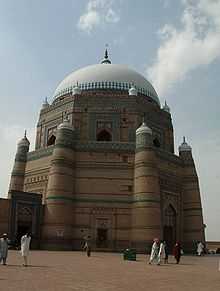





There is a saying in Persian that Multan is the 'City of Saints, Sufis and Beggars' (Gard, Garma, Gada o Goristan). It is one of the main cities in the southern Punjab province of Pakistan. The city has been a focal point for many religions, in particular becoming a central abode for Sufism, the mystical side of Islam. It has attracted Sufi saints from far places of the globe. Today, Multan is known as the 'City of Sufis'. Multan is one of the oldest cities in South Asia, with many tombs, shrines, temples, cathedrals and mausoleums, as well as a historical fort. Multan is now a combination of old and the new Pakistan culture.
There is a big hustle bustle in the old city and comforts of a five-star hotel and fine dining. The old city has bazaars selling mystical artifacts, perfumes, arts, and crafts. There are elaborately decorated shrines of the Sufi saints, tombs of travelers and important people in the old city of Multan.
The prime attractions of Multan are its mausoleums of Sufi saints. The Mausoleum of Sheikh Baha-ud-Din Zakariya, as well as the Mausoleum of Shah Rukn-e-Alam are the prime attractions. Their lofty domes oare visible from miles and dominate the skyline. Another popular shrine is the Mausoleum of Shams-ud-Din, commonly known as Shah Shamsuddin Sabzwari, located about half a mile to the east of the Multan Fort, on the high bank of the old bed of the Ravi River.
Another famous mausoleum of a warrior Sufi saint and poet Hazrat Hafiz Muhammad Jamal Multani (1747–1811 AD) is near Aam Khas garden outside Daulat Gate.
There are other mausoleums in the city that gather a great deal of attention. The Nuagaza tombs are shrines to martyrs and warriors who fought in wars centuries ago, some dating back 1,300 years. The Multan Museum has a vast collection of coins, medals, postage stamps of the former State of Bahawalpur, manuscripts, documented inscriptions, wood carvings, camel-skin paintings, historical models and stone carvings of the Islamic and pre-Islamic periods.
Multan old mosques that were once considered as the jewels of the city. Some have been dated to over 1,000 years ago and have been recognized as some of the oldest mosques in southeast Asia. The legend goes that the first mosque ever built in Multan was the Jamia Mosque which was constructed on the orders of General Mohammed Qasim, who conquered Multan in 712A D. Ruins of this mosque were visible till 1954 at Qasim Bella; however, due to repeated floods, the structure was lost. Sawi Mosque is supposed to be the oldest mosque which exists today, though in deteriorating state; there are glazed blue tiles from the era when it was built that dates the mosque to several centuries ago. The second oldest mosque in Multan is Mohammad Khan Wali Mosque. It is an excellent condition, in the busiest Chowck Bazar. It was built by Nawab Ali Mohammad Khan Khakwani in 1757 when he was the governor of Multan in the time of Alamgir II. The mosque is provided with a reservoir for ablutions, baths, and a large hall for prayers.
Multan has traditionally been a melting pot of distinct ethnic groups due to its location at the intersection of all four of Pakistan's main provinces and due to its historical significance as a centre of learning and culture. As a result, Multan consists of Punjabi, Baloch, Pashtun, Sindhi, Haryanvi and Urdu speaking people.
Multan is home of the Faysal Bank T20 Cup team: Multan Tigers. The city government inaugurated the new Multan Cricket Stadium, replacing Ibn-e-Qasim Bagh Stadium which was the lone one used for football and cricket matches. The inauguration of the new stadium has allowed the city to offer Test day/night matches as well as other national sports such as hockey, badminton and football. The stadium is home to the Multan Cricket Association. Other sports grounds include Divisional Sports Ground and the Pakistan Cricket Board owned Government College Cricket Ground.
Overseas Organization

In 2008, Haji Saleem Iqbal Foundes This organization to help poor Pakistani people Nishtar Medical College. Doctor graduates of this institution have spread across the world, and many have become established names in the field of medicine. The new Nishtar Institute of Dentistry provides dental and surgical services to Multan and the adjoining cities. The pioneer Punjab Government-chartered Institute of Southern Punjab Multan is the 2nd largest institute in Multan and 3rd largest in South Punjab. It was the first Education Institute in Punjab, and is the only private institute recognized by HEC in Multan.
Education

In 1950, then-Governor Abdur Rub Nishtar founded Nishtar Medical College. Doctor graduates of this institution have spread across the world, and many have become established names in the field of medicine. The new Nishtar Institute of Dentistry provides dental and surgical services to Multan and the adjoining cities. The pioneer Punjab Government-chartered Institute of Southern Punjab Multan is the 2nd largest institute in Multan and 3rd largest in South Punjab. It was the first Education Institute in Punjab, and is the only private institute recognized by HEC in Multan.
Multan Public School & College is a public institution in Multan City for providing quality education to the students of Multan as well as the other southern backward areas of Multan. Multan Public School, known as a Divisional Public School, provides boarding facilities for the students of far-flung areas. Multan Public School has a fleet of Hino Buses for pick and drop of the students.
Air University Multan is a leading Public sector University providing state of the art Higher Education at affordable fee. Air University Multan Campus AUMC has established new standards of Excellence in Academia in southern Punjab with diverse culture of Research & Development in Science & Technology.
Pakistan Institute of Engineering and Technology (PIET) is the new engineering college in Multan. It offers BSc Electrical, Civil and Mechanical engineering.
The NFC Institute of Engineering and Technological Training Multan (NFC-IET) is the training center of the National Fertilizer Corporation (NFC) of Pakistan. It is an engineering college serving mainly the areas of Southern Punjab province. It is one of the leading institutes in chemical engineering in Pakistan.
Bahauddin Zakariya University (formerly known as Multan University) is the main source of higher education for this region. The Swedish Institute of Technology in Multan is a campus of the Swedish Group of Technical Institutes, the largest private-sector organization providing technical education and vocational training in the Punjab.[25] Multan Medical and Dental College is the only private medical institution in Southern Punjab. Now more universities from federal are also opening campuses in Multan, such as AIR university, NUML (National University of Modern Languages), and MMDC (Multan Medical and Dental College), a private medical college. The Government High School Rid, Moza Rid, Chk 2 Faiz Multan is affiliated to BISE Multan and shows satisfactory results at secondary education level.
Cuisine

Multan is full of bazaars, mosques, shrines and plenty of places to have food. Restaurants serve array of cuisines including Pakistani, continental, fast, Arabic, BBQ and Chinese foods. Restaurants in Multan range from multinational chains like KFC, Subway, Pizza Hut, Hardee's, and Burger King to local places like Shahjahan Grill, Bundu Khan, MUX Lounge, and Restaurant Zanzibar. Some famous cuisines of the city are the Multani mutton chops and a special dessert named "Sohan halwa".
Two special sweet rotis, very common and famous among Multani families, are doli roti and busri.
Transportation

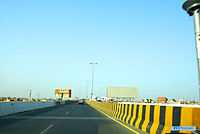

Multan has connections with other cities by a variety of means of transportation. The district has concrete road reaching up to 983.69 km. The district is linked with Khanewal, Lodhran and Muzaffargarh districts through concrete roads. Buses to Bahawalpur leave frequently, since it is located closely to the city. There are a variety of buses travelling farther from the city. Many of them are now air-conditioned with a fairly good safety record. The N-5 National Highway connects the city to connect to all parts of Pakistan. The road otherwise, known as GT Road, allows connections to Rawalpindi, Islamabad, Faisalabad, Karachi, Lahore as well as Bahawalpur. Coach services such as Daewoo Express, Faisal Movers Express, Niazi Express,Khan brothers transport, Nadir flying coach, Punjab Tourism Department, Skyways and New Khan Bus Service are some of the most reliable coach companies operating out of Multan.
Multan is connected by rail with all parts of the country and lies on the main track between Karachi, Peshawar, Lahore and Quetta. The main Peshawar-Karachi railway line passes through Multan district. The district then links trains to nearby districts of Khanewal, Lodhran and Muzafargarh districts through the railway network.[26] Multan Cantonment railway station is the main railway station of Multan.
Multan International Airport is an airport situated 10 km away from the city centre of Multan. It is not as large as the other airports in Pakistan, as it operates to cater mainly to the population of Multan, Vehari, Khanewal, Muzaffargarh, Rajanpur, Sahiwal, and Pakpattan to mainly to other points within Pakistan as well as the Middle East. Flight are currently operated by the national flag carrier, Pakistan International Airlines. However, since the growth of air travel within the region, there has been speculated interest from other private carriers. The rise in air-travel has also led to the expansion of the current airport with a new runway and terminal.
Notable saints of Multan
- Shah Yousaf Gardezi (d. 1136), tomb located inner Bohar Gate Multan
- Mai Maharban (11/12th Century), tomb located near Chowk Fawara, children complex Multan
- Bahauddin Zikarya (1170–1267), tomb located in Multan Fort
- Shah Rukne Alam (1251–1335), tomb located in Multan Fort
- Khawaja Awais Kagha (d. 1300), tomb located in Dera Basti graveyard Multan
- Syed Musa Pak (d. 1592)
- Hafiz Muhammad Jamal Multani (1747–1811)
- Syed Ata Ullah Shah Bukhari (1892–1961), buried in Jalal Bakri
Sports
- Professional Multan team
| Club | League | Sport | Venue | Established |
|---|---|---|---|---|
| Multan Tigers | Faysal Bank T20 Cup | Cricket | Multan Cricket Stadium | 2004 |
Notable people from Multan
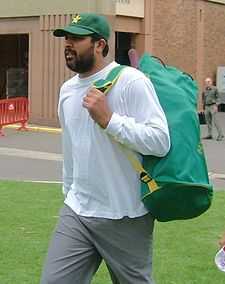
Sister cities
Multan has a friendship agreement with three cities in the world as of 2011:
See also
- Multan Museum
- Multan Fort
- Multan International Airport
- List of places in Multan
- History of Multan
- Climate of Multan
- City Wall of Multan
- Siege of Multan
- Battle of Multan
- Mausoleums of Multan
- Multan Division
- Multan District
- Hindu temples in Multan
- List of educational institutions in Multan
- Mosques of Multan
- NFC Institute of Engineering and Technological Training
- Multan Institute of Professional Studies Multan
- multan parks
References
- ↑
- ↑ Area reference
Density reference - ↑ "Multan District at Glance". Population Census Organization, Government of Pakistan. Retrieved 26 June 2011.
- ↑ Multan History according to Multan Official Website
- ↑ Multan history according to Multan Police official website
- ↑ Katoch Dynasty as per DAWN News
- ↑ Singh, Fauja. History of the Punjab: Pre-historic times to age of Asoka. Pg.41. Retrieved 2 June 2009.
- ↑ Sircar, D.C. Studies in the Geography of Ancient and Medieval India. Pg.52. Retrieved 2 June 2009.
- ↑ "Multān City - Imperial Gazetteer of India, v. 18, p. 35". Dsal.uchicago.edu. Retrieved 11 August 2012.
- ↑ Hindu History BY Akshoy K Majumdar Published by Rupa and CO PAGE 54
- ↑ 11.0 11.1 11.2 11.3 Virani, Shafique N. The Ismailis in the Middle Ages: A History of Survival, A Search for Salvation (New York: Oxford University Press), p. 100.
- ↑ Adrian Marsh. [Gypsies and the problem of identities: contextual, constructed and contested, Volume 2003]. Swedish Research Institute in Istanbul, 2006. ISBN 91-86884-17-4, ISBN 978-91-86884-17-8
- ↑ Beck, Sanderson. "Mughal Conquest of India 1526-56". INDIA & Southeast Asia to 1800. Retrieved 11 June 2009.
- ↑ Tazkirat us-Salatin Chaghta – A Mughal Chronicle of Post Aurangzeb Period (1707-1724) by Muhammad Hadi Kamwar Khan; edited Persian text and with an Introduction by Muzaffar Alam (1980), Centre Of Advanced Study Department of History, Aligarh Muslim University, Aligarh (U.P.) -202001, India(page 226)
- ↑ "Dictionary of Battles and Sieges: A-E". Retrieved 29 December 2014.
- ↑ Roy, Kaushik. India's Historic Battles: From Alexander the Great to Kargil. Permanent Black, India. pp. 80–1. ISBN 978-81-7824-109-8.
- ↑ Elphinstone, Mountstuart (1841). History of India. John Murray, Albermarle Street. p. 276.
- ↑ Dictionary of Battles and Sieges: F-O - Tony Jaques - Google Books. Books.google.co.in. Retrieved 11 August 2012.
- ↑ Ranjit Singh: And the Sikh Barrier Between British Empire and Central Asia - William Wilson Hunter - Google Books. Books.google.co.in. Retrieved 11 August 2012.
- ↑ "Multan History -City District Government Multan". Multan.gov.pk. Retrieved 11 August 2012.
- ↑ Harbans Singh "The Heritage of the Sikhs"
- ↑ Multan Developemt Authority Official website says 50 Deg Highest
- ↑ Doaba Foundation web Link about Climate of Multan
- ↑ "Multan Climate Normals 1961-1990". National Oceanic and Atmospheric Administration. Retrieved 16 January 2013.
- ↑
- ↑ Transport in Multan Lonely Planet Travel Information. Accessed 15 August 2009.
- ↑ http://www.thenews.com.pk/daily_detail.asp?id=145013
- ↑ "Ministry of Foreign Affairs". Mofa.gov.pk. 31 October 2008. Retrieved 11 August 2012.
- ↑ "Gilani visits land of his forefathers - Thaindian News". Thaindian.com. 14 September 2011. Retrieved 11 August 2012.
External links
-
 Multan travel guide from Wikivoyage
Multan travel guide from Wikivoyage - Multan City government website
- Britannica: Multan
- Multan City portal
- Historic Places Preservation Project Multan
- SEO Services Multan
| ||||||||||||||||||||||
| ||||||||||||||||||||||||||||||
| ||||||||||||||||||||||||||||||||||
| ||||||||||||||||||||||||||||||||||||||||||||||||||||||||||||||||||||||||||||||||||||||||||||||||||||||||||||||||||||||||||||||||||||||||||||||||||||||||||||||||||||
